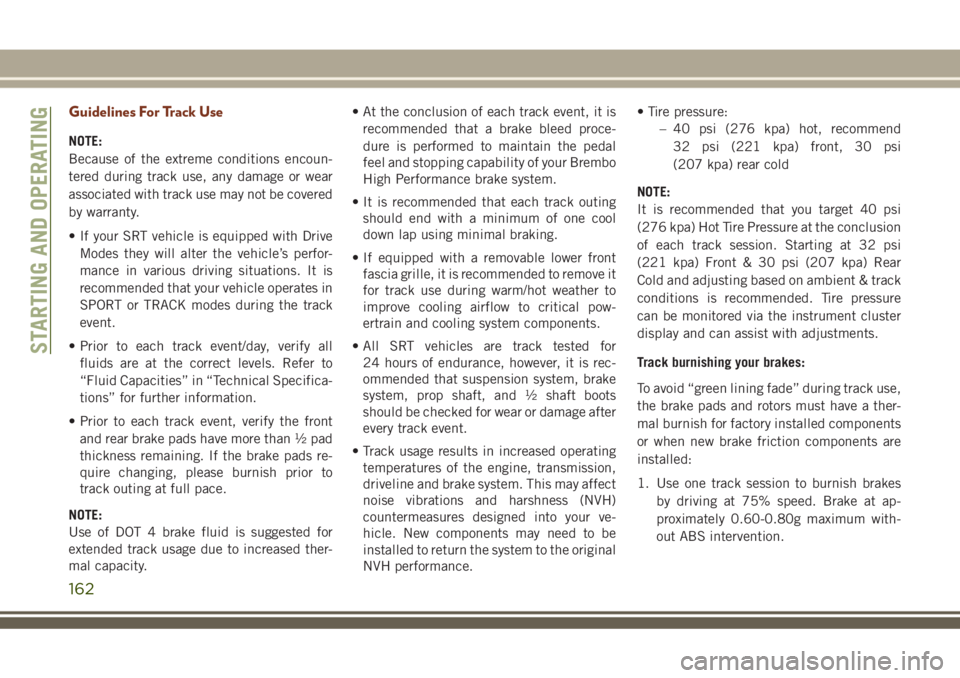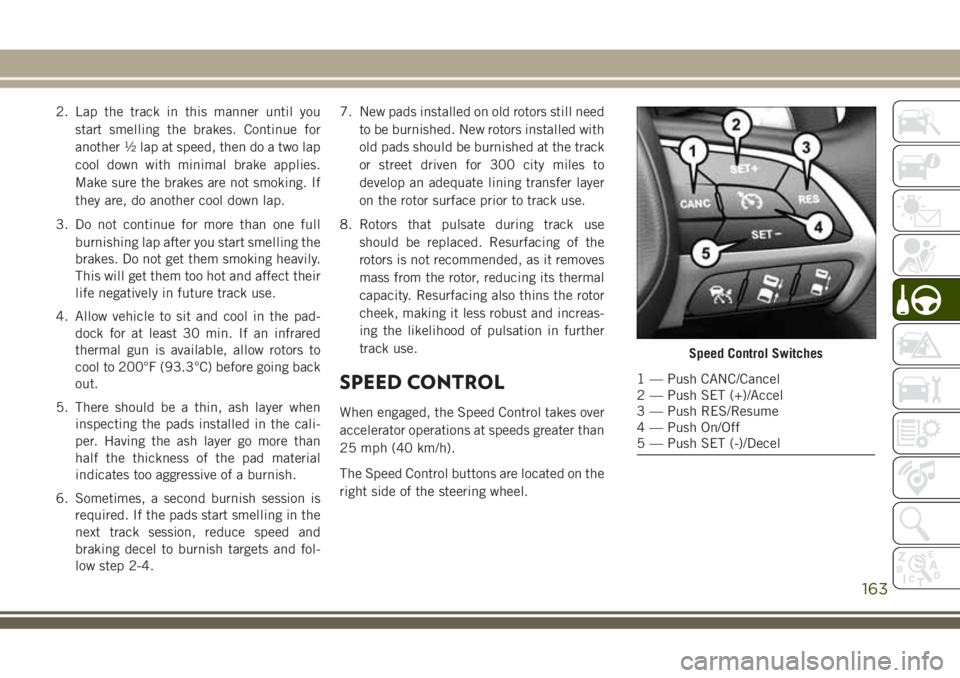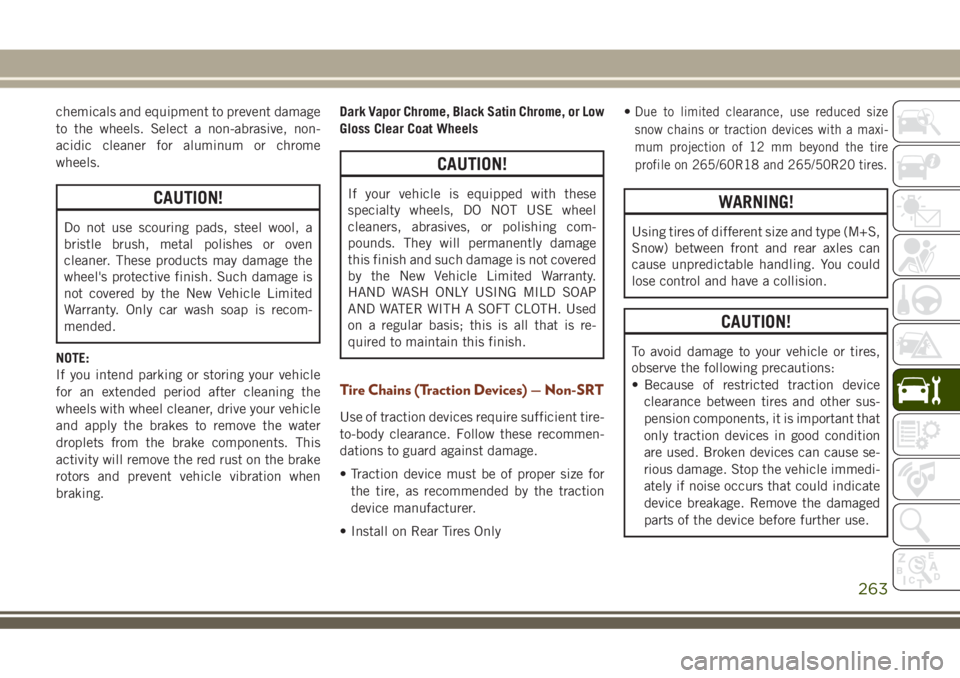brake pads JEEP GRAND CHEROKEE 2018 Owner handbook (in English)
[x] Cancel search | Manufacturer: JEEP, Model Year: 2018, Model line: GRAND CHEROKEE, Model: JEEP GRAND CHEROKEE 2018Pages: 368, PDF Size: 5.72 MB
Page 164 of 368

Guidelines For Track Use
NOTE:
Because of the extreme conditions encoun-
tered during track use, any damage or wear
associated with track use may not be covered
by warranty.
• If your SRT vehicle is equipped with Drive
Modes they will alter the vehicle’s perfor-
mance in various driving situations. It is
recommended that your vehicle operates in
SPORT or TRACK modes during the track
event.
• Prior to each track event/day, verify all
fluids are at the correct levels. Refer to
“Fluid Capacities” in “Technical Specifica-
tions” for further information.
• Prior to each track event, verify the front
and rear brake pads have more than ½ pad
thickness remaining. If the brake pads re-
quire changing, please burnish prior to
track outing at full pace.
NOTE:
Use of DOT 4 brake fluid is suggested for
extended track usage due to increased ther-
mal capacity.• At the conclusion of each track event, it is
recommended that a brake bleed proce-
dure is performed to maintain the pedal
feel and stopping capability of your Brembo
High Performance brake system.
• It is recommended that each track outing
should end with a minimum of one cool
down lap using minimal braking.
• If equipped with a removable lower front
fascia grille, it is recommended to remove it
for track use during warm/hot weather to
improve cooling airflow to critical pow-
ertrain and cooling system components.
• All SRT vehicles are track tested for
24 hours of endurance, however, it is rec-
ommended that suspension system, brake
system, prop shaft, and ½ shaft boots
should be checked for wear or damage after
every track event.
• Track usage results in increased operating
temperatures of the engine, transmission,
driveline and brake system. This may affect
noise vibrations and harshness (NVH)
countermeasures designed into your ve-
hicle. New components may need to be
installed to return the system to the original
NVH performance.• Tire pressure:
– 40 psi (276 kpa) hot, recommend
32 psi (221 kpa) front, 30 psi
(207 kpa) rear cold
NOTE:
It is recommended that you target 40 psi
(276 kpa) Hot Tire Pressure at the conclusion
of each track session. Starting at 32 psi
(221 kpa) Front & 30 psi (207 kpa) Rear
Cold and adjusting based on ambient & track
conditions is recommended. Tire pressure
can be monitored via the instrument cluster
display and can assist with adjustments.
Track burnishing your brakes:
To avoid “green lining fade” during track use,
the brake pads and rotors must have a ther-
mal burnish for factory installed components
or when new brake friction components are
installed:
1. Use one track session to burnish brakes
by driving at 75% speed. Brake at ap-
proximately 0.60-0.80g maximum with-
out ABS intervention.
STARTING AND OPERATING
162
Page 165 of 368

2. Lap the track in this manner until you
start smelling the brakes. Continue for
another ½ lap at speed, then do a two lap
cool down with minimal brake applies.
Make sure the brakes are not smoking. If
they are, do another cool down lap.
3. Do not continue for more than one full
burnishing lap after you start smelling the
brakes. Do not get them smoking heavily.
This will get them too hot and affect their
life negatively in future track use.
4. Allow vehicle to sit and cool in the pad-
dock for at least 30 min. If an infrared
thermal gun is available, allow rotors to
cool to 200°F (93.3°C) before going back
out.
5. There should be a thin, ash layer when
inspecting the pads installed in the cali-
per. Having the ash layer go more than
half the thickness of the pad material
indicates too aggressive of a burnish.
6. Sometimes, a second burnish session is
required. If the pads start smelling in the
next track session, reduce speed and
braking decel to burnish targets and fol-
low step 2-4.7. New pads installed on old rotors still need
to be burnished. New rotors installed with
old pads should be burnished at the track
or street driven for 300 city miles to
develop an adequate lining transfer layer
on the rotor surface prior to track use.
8. Rotors that pulsate during track use
should be replaced. Resurfacing of the
rotors is not recommended, as it removes
mass from the rotor, reducing its thermal
capacity. Resurfacing also thins the rotor
cheek, making it less robust and increas-
ing the likelihood of pulsation in further
track use.
SPEED CONTROL
When engaged, the Speed Control takes over
accelerator operations at speeds greater than
25 mph (40 km/h).
The Speed Control buttons are located on the
right side of the steering wheel.
Speed Control Switches
1 — Push CANC/Cancel
2 — Push SET (+)/Accel
3 — Push RES/Resume
4 — Push On/Off
5 — Push SET (-)/Decel
163
Page 265 of 368

chemicals and equipment to prevent damage
to the wheels. Select a non-abrasive, non-
acidic cleaner for aluminum or chrome
wheels.
CAUTION!
Do not use scouring pads, steel wool, a
bristle brush, metal polishes or oven
cleaner. These products may damage the
wheel's protective finish. Such damage is
not covered by the New Vehicle Limited
Warranty. Only car wash soap is recom-
mended.
NOTE:
If you intend parking or storing your vehicle
for an extended period after cleaning the
wheels with wheel cleaner, drive your vehicle
and apply the brakes to remove the water
droplets from the brake components. This
activity will remove the red rust on the brake
rotors and prevent vehicle vibration when
braking.Dark Vapor Chrome, Black Satin Chrome, or Low
Gloss Clear Coat Wheels
CAUTION!
If your vehicle is equipped with these
specialty wheels, DO NOT USE wheel
cleaners, abrasives, or polishing com-
pounds. They will permanently damage
this finish and such damage is not covered
by the New Vehicle Limited Warranty.
HAND WASH ONLY USING MILD SOAP
AND WATER WITH A SOFT CLOTH. Used
on a regular basis; this is all that is re-
quired to maintain this finish.
Tire Chains (Traction Devices) — Non-SRT
Use of traction devices require sufficient tire-
to-body clearance. Follow these recommen-
dations to guard against damage.
• Traction device must be of proper size for
the tire, as recommended by the traction
device manufacturer.
• Install on Rear Tires Only•
Due to limited clearance, use reduced size
snow chains or traction devices with a maxi-
mum projection of 12 mm beyond the tire
profile on 265/60R18 and 265/50R20 tires.
WARNING!
Using tires of different size and type (M+S,
Snow) between front and rear axles can
cause unpredictable handling. You could
lose control and have a collision.
CAUTION!
To avoid damage to your vehicle or tires,
observe the following precautions:
• Because of restricted traction device
clearance between tires and other sus-
pension components, it is important that
only traction devices in good condition
are used. Broken devices can cause se-
rious damage. Stop the vehicle immedi-
ately if noise occurs that could indicate
device breakage. Remove the damaged
parts of the device before further use.
263